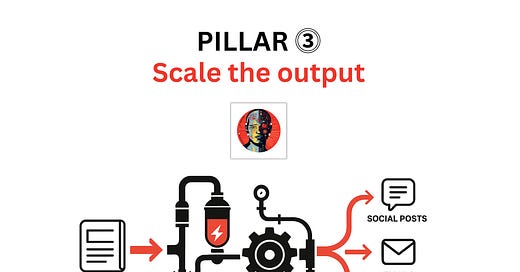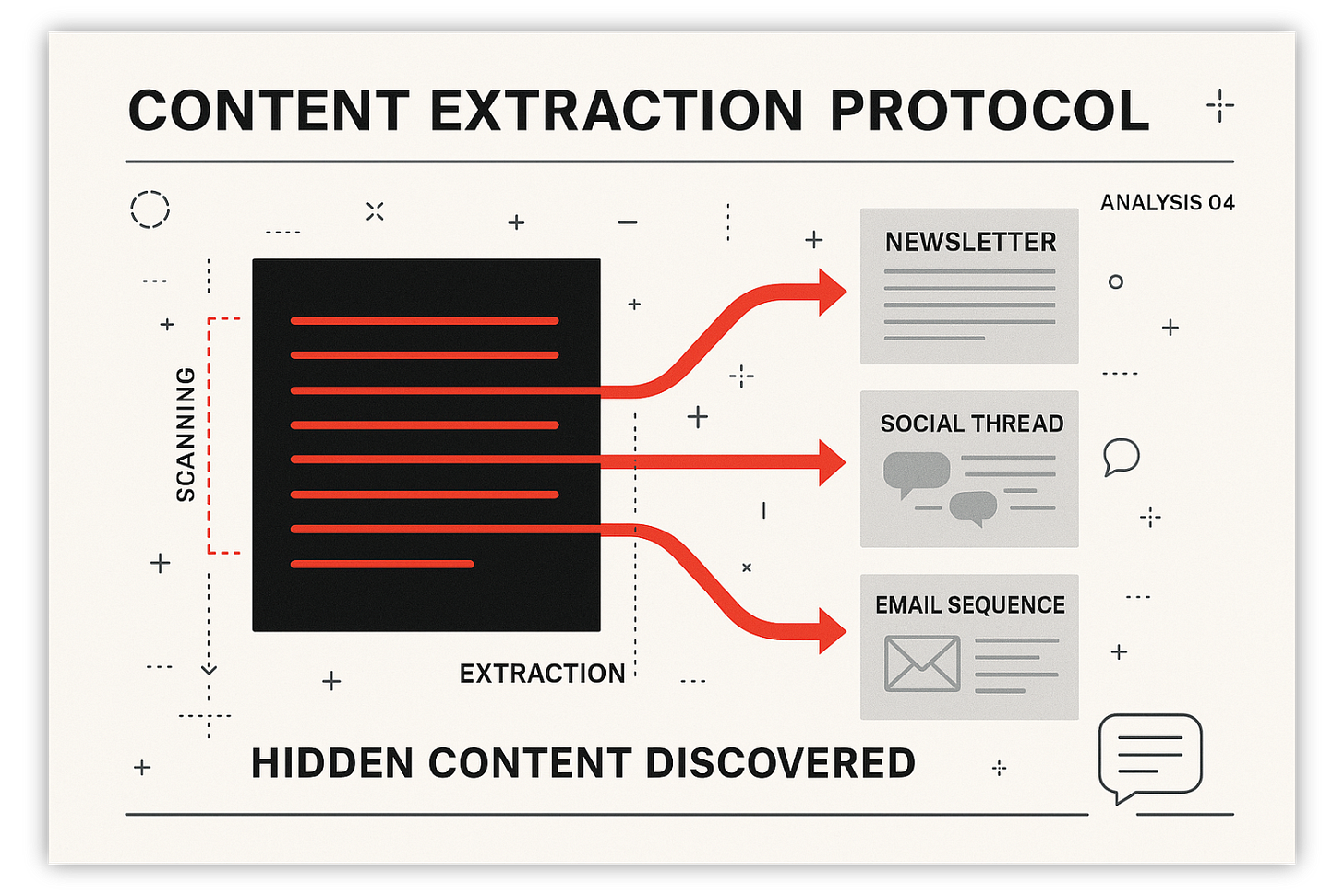In Pillar 1, we explored building your knowledge base. In Pillar 2, we covered collaboration with AI. Now we complete the framework with the pillar that transforms everything: systematic scaling.
Most creators are still trapped with one-piece-at-a-time. They write a newsletter, hit publish, and immediately start trying to fill the next blank page. They're playing content creation on hard mode and wondering why they're burning out.
Not familiar with my 3-pillar AI writing system yet? → Read this first
The one-piece-at-a-time trap
Here's what I see happening everywhere: creators spend their entire Sunday afternoon crafting the perfect newsletter. They hit publish on Monday morning, get some likes and comments, then freak out a bit about what to write next week.
Meanwhile, that newsletter just sits there. Published once, then forgotten.
This is the outdated approach that's keeping most creators stuck. Publish once, move on. Start from scratch every single time.
But here's what I learned from building my own AI content repurposing systems for this newsletter, ghostwriting for AI founders, and running content ops at fast-moving startups that require multiple pieces of fresh content weekly: the creators who win aren't just better writers. They're better at multiplication.
They've moved from creating individual pieces to building content engines.
Pillar 3 completes your AI writing system
When you have a solid knowledge base from Pillar 1 and you've mastered the collaboration approach from Pillar 2, something interesting happens.
You're no longer just creating content. You're creating systematically with context, voice, and intention behind every piece.
That's when Pillar 3 becomes transformational.
Because now when you create something, you're not just creating one asset. You're creating the foundation for dozens of pieces. They all carry your authentic voice and build on the knowledge you've systematically fed your AI.
This is the shift from content creation to content engines. And it's where the real leverage begins.
The content multiplication framework
The core principle is simple: one idea should become ten pieces of content. Not ten versions of the same thing, but ten different angles, formats, and applications.
Most people think this means taking a newsletter and chopping it up into social media quotes.
That's not multiplication. That's dilution.
Real multiplication starts with strategic content selection. Not every piece is worth multiplying. The content that scales best is comprehensive, evergreen, and contains multiple distinct concepts that can stand alone.
When you feed this kind of content into your AI system, you can extract angles you never consciously included. Your AI will find the hidden newsletter inside your video transcript, the social media thread buried in your case study, the email sequence waiting inside your product launch.
The extraction process becomes a conversation with your AI. "What are the three strongest standalone concepts in this piece?" "How would you adapt this framework for someone just getting started?" "What questions does this content answer that I didn't explicitly address?"
Your AI helps you discover what's hiding in your content.
You need a content repurposing system (not random repurposing)
Here's the difference between creators who scale and creators who burn out: systems versus random acts of repurposing.
Random repurposing is what most people do. They remember they have some old content, pull out a few quotes, maybe turn a blog post into a LinkedIn article when they're desperate for content.
Systematic repurposing is different. It's building repeatable workflows that treat every piece of content as the seed for an entire content ecosystem.
When you approach repurposing systematically, you're building compound interest on every hour you've ever spent creating.
The creators who understand this aren't scrambling for content ideas. Their biggest problem is choosing which of their dozens of extracted concepts to publish next.
Your archive isn't dead content gathering digital dust. It's a gold mine you haven't learned to excavate yet.
Content multiplication in practice
Let's get specific about what multiplication actually looks like.
Take this 3-pillar series we're wrapping up. Three newsletters about building AI writing systems. But watch what happens when you apply systematic multiplication: these three pieces become a mini handbook for subscribers. They become a lead magnet for new readers. They become the foundation for social media content, video scripts, and email sequences. They become the curriculum outline for future training programs.
One series, dozens of applications that all maintain the same voice and systematic approach.
Each piece maintains your voice because your AI system knows how you think and speak. Each piece serves a different platform and audience segment.
This is format transformation in action. Your newsletter isn't just becoming more newsletters. It's becoming the kind of content that works across every platform and format you need.
But here's the key: cross-platform adaptation doesn't mean generic content. When your AI system has proper context about you and your audience, it can maintain your authentic voice while adapting the structure, tone, and depth for different platforms.
The LinkedIn version sounds like you on LinkedIn. The email version sounds like you in someone's inbox. The video script sounds like you speaking.
This is how past work becomes future assets. Every piece you create with this system is building the foundation for months of future content.
What changes when you scale systematically
When you implement systematic scaling, the entire content creation game shifts.
First, you stop panicking about content calendars. When every piece you create becomes the seed for multiple formats and angles, you're always working weeks ahead instead of scrambling for next week's ideas.
Second, you build creative compound interest. Each piece of content becomes more valuable over time as you discover new angles and applications. Your archive transforms from a graveyard of old posts into a living asset that generates fresh content.
Third, you move from content chaos to content leverage. Instead of feeling overwhelmed by the demand to constantly create new things, you start seeing content creation as a strategic investment. Every hour you spend creates exponential returns.
Bringing all three pillars together
Now you can see how the entire system works together.
Pillar 1 gave your AI the knowledge it needs to think and write like you. Pillar 2 taught you to collaborate instead of outsourcing your voice. Pillar 3 shows you how to multiply that collaboration across formats and platforms systematically.
Together, these three pillars create something most creators never build: a personal AI writing assistant that knows you, works with you, and scales with you.
Your complete AI writing system helps you think clearer, create more strategically, and scale your ideas without losing what makes them authentically yours.
This is how you build content engines instead of just creating content.
This is how you turn scattered AI usage into systematic leverage.
This is how you create at scale without sounding like a template.
We've covered the complete framework: building knowledge, co-writing with AI, and scaling the output.
Our community is building AI systems that think, write, and scale with us.
Alex
Founder of AI Disruptor
PS: If you want to start building your own system, consider becoming a premium subscriber. You can expect prompt drops, system building tips, knowledge docs, future ebooks, and more. If you sign up today, you receive access to my AI Newsletter Starter Pack.






